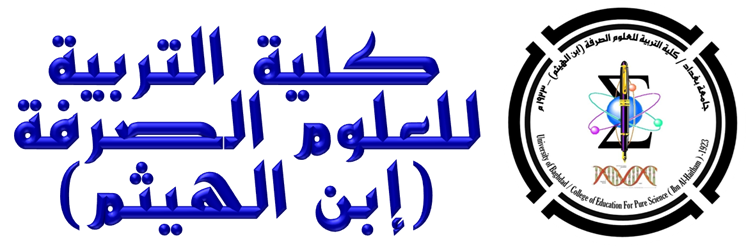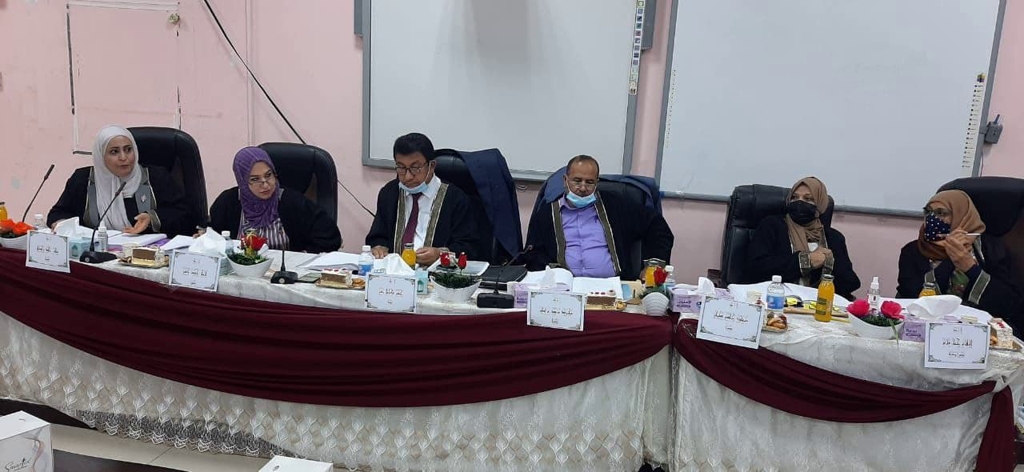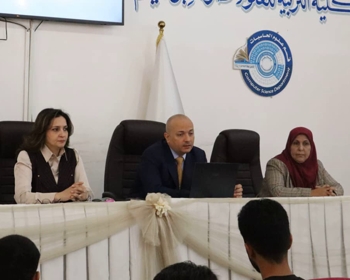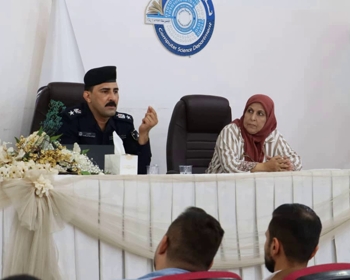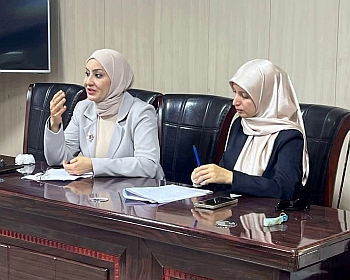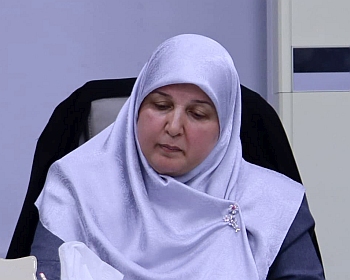ناقش قسم الرياضيات في كلية التربية للعلوم الصرفة (ابن الهيثم) أطروحة الدكتوراه الموسومة (تصميم تعليمي- تعلمي وفقاً لاستراتيجيات التعلم الموقفي وأثره في التحصيل و التفكير المستقبلي و التنور الرياضي لدى طلاب الصف الثاني المتوسط) في تخصص طرائق تدريس الرياضيات للطالب (محمد إبراهيم مهدي) التي انجزها تحت اشراف التدريسية في القسم (أ.م.د. الهام جبار فارس) ونوقشت من قبل أعضاء لجنة المناقشة المبينة أسمائهم في ما يأتي :
-
أ.د. حسن كامل رسن (رئيسا)
-
أ.م.د. ميعاد جاسم سلمان عضوا)
-
أ.م.د. محمد مريد عراك (عضوا)
-
أ.م.د. اريج خضر حسن (عضوا)
-
أ.م.د. عفاف زياد وادي (عضوا)
-
أ.م.د. الهام جبار فارس (عضوا و مشرفا)
هدف البحث إلى بناء تصميم تعليمي,– تعلمي وفقاً لاستراتيجيات التعلم الموقفي, ومعرفة أثره في التحصيل والتفكير المستقبلي والتنوّر الرياضي لدى طلاب الصف الثاني المتوسط.
ولتحقيق الهدف تم بناء تصميم تعليمي – تعلمي في ضوء المراحل الاتية (التحليل, التصميم, التنفيذ, التقويم) في مرحلة التحليل تم اجراء(تحليل الاهداف التعليمية, تحديد المحتوى, تحديد الفئة المستهدفة, تحليل البيئة التعليمية, تحليل خصائص الطلاب, تحديد الحاجات التعليمية) وفي مرحلة التصميم والتطوير تم اجراء (صياغة الاهداف السلوكية, تقسيم المادة الدراسية, تهيئة متطلبات التصميم, بناء الاختبارات وذلك على النحو الاتي:
-
اختبار تحصيل تكون بصيغته النهائية من (40) فقرةً مكوّنة من فقرات موضوعية (من نوع الاختيار من متعدد) و فقرات مقالية.
-
اختبار التفكير المستقبلي مكون من 22)) فقرة مقالية وموضوعية موزّعة بين المهارات الأربع للتفكير المستقبلي (التنبؤ(7) فقرات, التوقع(7) فقرات, التصور(4) فقرات, حلّ المشكلات المستقبلي(4) فقرات).
-
اختبار التنوّر الرياضي مكون من (51) فقرةً موزًعةً على الأبعاد التالية: المعرفية (14) فقرة اختيار من متعدد, المهارية (14) فقرة اختيار من متعدد, وجدانية (23) فقرة وفق سلم ليكرت الثلاثي.
إذ تمّ تطبيق الاختبارات على عينة استطلاعية أولى للتحقق من وضوح فقرات كل اختبار وتعليماته وتحديد زمنه, وعينة استطلاعية ثانية لإجراء التحليلات الإحصائية المناسبة، والتأكد من الخصائص السايكومترية التي بموجبها أصبحت الاختبارات جاهزة للتطبيق على مجموعتي البحث.
وفي مرحلة التنفيذ اتبع الباحث, منهج البحث التجريبي، واعتمد فيه التصميم شبه تجريبي ذا المجموعتين المتكافئتين ذواتي الاختبار البعدي لقياس التحصيل والتفكير المستقبلي و التنوّر الرياضي، ووضعت الفرضيات الصفرية المناسبة للتحقق من الاهداف, كذلك تم تحديد مجتمع البحث طلاب الصف الثاني المتوسط في المدارس المتوسطة والثانوية النهارية التابعة للمديرية العامة لتربية كربلاء المقدسة، إذ تمً اختيار عينة البحث قصدياً المتكونة من(36) طالباً من طلاب الصف الثاني المتوسط من مدرسة متوسطة أمام المتقين للبنين موزعين بين مجموعتي البحث بالتساوي :
– مجموعة تجريبية دُرّست بالتصميم (التعليمي- التعلمي) وفقاً لاستراتيجيات التعلم الموقفي.
– مجموعة ضابطة دُرّست بالطريقة الاعتيادية .
وقد تمً إجراء التكافؤ بين مجموعتي البحث إحصائياً في متغيرات (العمر الزمني، والتحصيل السابق لمادة الرياضيات، والذكاء، والمعلومات السابقة).
مرحلة التقويم بعد تنفيذ التجربة في الفصل الدراسي الاول, من العام الدراسي (2020- 2021) من قبل الباحث وعلى وفق, التصميم التعليمي- التعلمي الذي اعده الباحث لهم, قام بتطبيق الاختبارين التحصيلي, التفكير المستقبلي, واختبار التنوّر الرياضي, على طلاب المجموعتين, و تمت معالجة البيانات احصائياً (t-test) لعينتين مستقلتين, وأشارت النتائج إلى وجود فرق ذي دلالة إحصائية, لصالح طلاب المجموعة التجريبية, الذين دُرّسوا مادة تجربة البحث بالتصميم (التعليمي- التعلمي) وفقاً لاستراتيجيات التعلم الموقفي, وبين طلاب المجموعة الضابطة الذين دُرسوا مادة تجربة البحث على وفق الطريقة الاعتيادية في التحصيل والتفكير المستقبلي والتنور الرياضي، وفي ضوء نتائج البحث توصل الباحث الى مجموعة من استنتاجات, منها ان التدريس وفق تصميم تعليمي- تعلمي وفقاً لاستراتيجيات التعلم الموقفي له أثر في التحصيل الدراسي, و التفكير المستقبلي, والتنوّر الرياضي, لطلاب عينة البحث وفي ضوء تلك الاستنتاجات وضع عدداً من المقترحات والتوصيات.
Educational Design- Learning According to Situational Learning Strategies and its Effect on Achievement, Future Thinking and Enlightenment in Mathematics For Second-Grad Intermediate Students
By Mohammed Ibrahim Mahdi
Supervised by Asst. Prof. Dr. Ilham Jabbar Faris
Abstract
The aim of the research is to prepare an educational design – learning according to the attitudinal learning strategies, and to know its effect on achievement, future thinking and mathematical enlightenment among second-grade intermediate students
To achieve the goal of the study was prepared Instructional- Learning design was prepared in light of the stages (analysis, design. Implementation, evaluation). As far as the analysis stage consisting of ( analysis of educational objectives, determination of content, identification of the target group, analysis of the educational environment, analysis of the target group, analysis of the educational environment),analysis of student characteristics, identification of educational needs) and in the design stage and development formulating behavioral goals, dividing the course material, preparing design requirements, building two tests and a scale as follows.
Two tests were made according to the following
Obtainment test with its final formula consists of (36) objective paragraphs of multi-test
Test of future thinking consists of (22) paragraphs as an article distributed among the four skills for future thinking ( Data prediction (7) paragraphs, Expectation (7) paragraphs, mental imagery (4) paragraphs and to solve future problems
Enlightenment standard in mathematics consists of (51) paragraphs distributed into, knowledge (14) paragraphs, multiple choice. Skill (14) paragraphs, multiple choice, sentiment (23) Likert Scale of 3 points
In the implementation stage, the researcher followed the quasi-experimental method of research. It depends on the experimental design of two equal groups with post-test was adopted to measure achievement, future thinking and mathematical enlightenment. As well as the appropriate null hypotheses were developed to achieve the goals, as well as the research community was identified second-grade middle school students in middle and high school daytime Affiliated to the General Directorate of Holy Karbala Education, the research sample consisting of (36) middle school students from an intermediate school in front of Imam Al. Muttaq in Secondary School for Boys was selected, distributed equally between the two research groups:
Experimental group who studied the design (educational – learning) according situated learning.
Control group who studied according the ordinary method
Equivalence was made between the two research groups statistically in the variables chronological age, previous mathematics achievement, intelligence, and previous information
The evaluation stage after implementing the experiment in the first semester of the academic year (2020-2021) by the researcher and according to the instructional-learning design prepared by the researcher for them. He applied the two achievement tests: future thinking, and the mathematical enlightenment scale, on the students of the two groups, and the data were processed statistically (t-test) for two independent equal samples. The results indicated a statistically significant difference, in favor of the experimental group students. They taught the subject of the research experiment by design (educational – learning). According to the situational learning strategies, and among the control group students who studied the subject of the research experience according to the usual method, and the research results
The researcher reached a set of conclusions, including that teaching according to an instructional-learning design according to the attitude learning strategies has an effect on academic achievement and thinking Future, and mathematical enlightenment, for the students of the research sample, and according to conclusions, a number of proposals and recommendations were put forward
